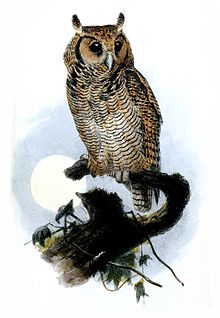Fraser's eagle-owl
| Fraser's eagle-owl | |
|---|---|
 |
|
| Scientific classification | |
| Kingdom: | Animalia |
| Phylum: | Chordata |
| Class: | Aves |
| Order: | Strigiformes |
| Family: | Strigidae |
| Genus: | Bubo |
| Species: | B. poensis |
| Binomial name | |
|
Bubo poensis Fraser, 1853 |
|
| Synonyms | |
|
|
Fraser's eagle-owl (Bubo poensis) is a species of African owl in the family Strigidae. It is named after the British zoologist Louis Fraser.
Fraser's eagle-owl is a relatively small species of eagle-owl with has rather "fluffy" ear tufts and a facial disc with a distinct dark rim. The upperparts are rufous and buffy brown, barred with darker bars, the pale scapulars have dark edged outer webs which show as a series of pale dots across the shoulder. The flight and tail feathers have narrow light and dark bars. The underparts are pale rufous shading to whitish on the belly and undertail coverts. Total length 39–42 cm (15–17 in), females larger than males.
The territorial song of the male Fraser’s eagle-owl is a rapid, stuttering and long deep, guttural trill which has been said to resemble the noise made by an electricity generator. There is also a two syllable hoot, which is stereotypically owl like, with the second syllable being higher pitched and more whistled. The double hoot is repeated at intervals of 3–4 seconds, and to the listener familiar with it, similar to the hoot of the European tawny owl. Another call, which is given by both sexes, used is a single soft mewing "wooh". They snap their bills to communicate, as do many owls.
From Liberia, Ivory Coast and Ghana then from Nigeria east to eastern Uganda, south to far north western Angola. Also found on Bioko.
Their habitat is primarily forest, forest clearings, and cardamom plantations. Ranges from sea-level up to about 1,600 m (5,200 ft), in Cameroon.
Like most owls Fraser's eagle-owl is a nocturnal bird, roosting during the day hidden by leaves, about 40 m (130 ft) above the ground. The roost site is often located by small, diurnal birds which mob the owl. The birds stop roostng at dusk and become active, singing is most often in the early evening, just after dusk, but they will also sing just before dawn. Its main prey is small mammals, such as mice, squirrels and galagos, and it also takes birds, frogs, reptiles, insects and other arthropods as well as the occasionally feeding on fruit.
...
Wikipedia

